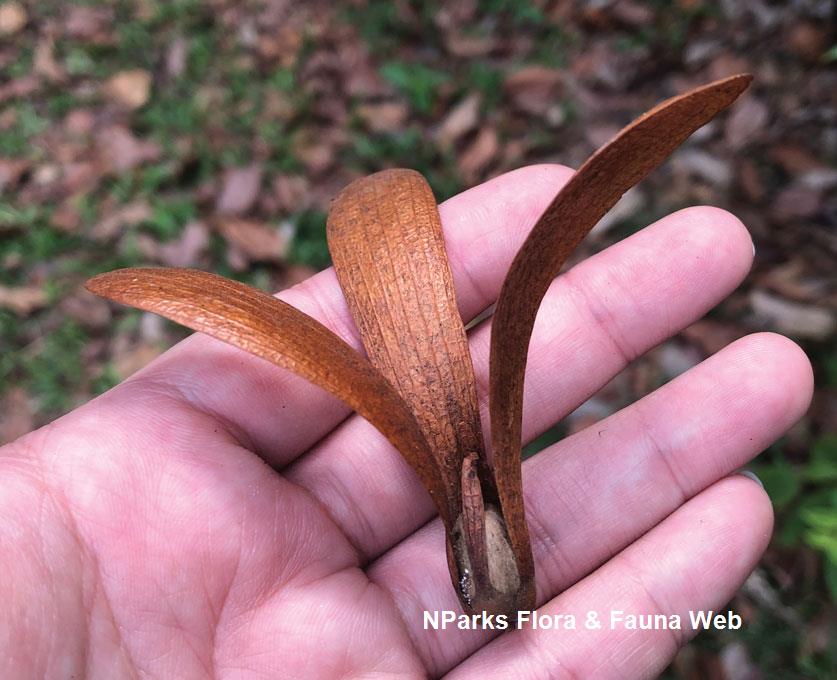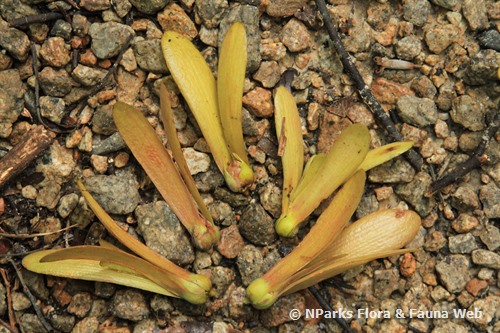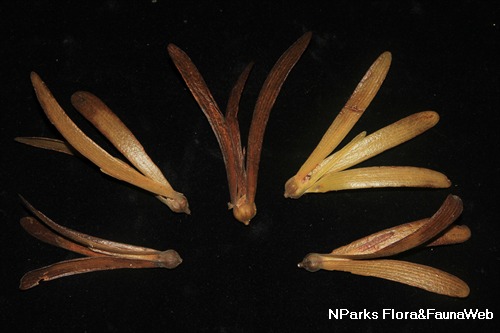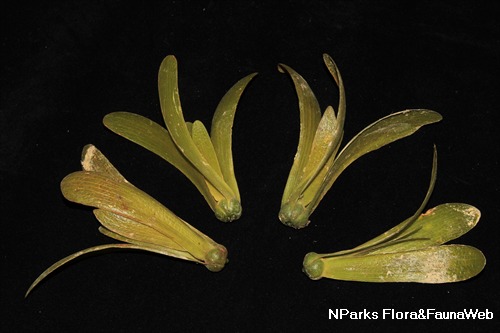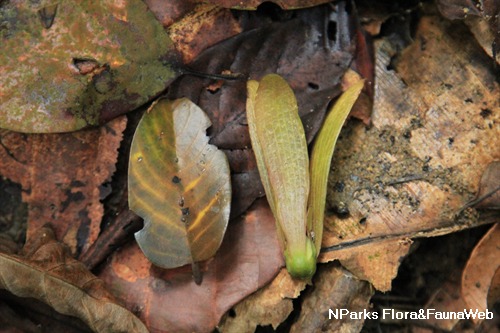
Back
Rubroshorea parvifolia (Dyer) P.S.Ashton & J.Heck.
| Family Name: | Dipterocarpaceae |
| Synonyms: | Shorea parvifolia Dyer |
Rubroshorea parvifolia or Light Red Meranti is a large emergent tree native to Singapore. Growing to a height of 65 m tall, it has buttresses, round to dome-shaped crown. Leaves are slightly leathery, egg to narrowly egg-shaped with 10 - 14 pairs of slightly curved veins. Flowers are clustered in 8 (more or less), strongly fragrant, white to cream coloured, 5 overlapping petals with gradual hints of pink from the base. The fruit is a 5-winged nut with 3 long lobes and 2 short lobes, sparsely hairy while the nut is oval to round with a tail-like tip. When young, the winged fruit is light pink, drying to brown upon maturity.
Name
Classifications and Characteristics
| Plant Division | Angiosperms (Flowering Seed Plants) (Dicotyledon) |
|---|---|
| Plant Growth Form | Tree (Big (>30m)) |
| Lifespan (in Singapore) | Perennial |
| Plant Shape | Rounded |
| Maximum Height | 65 m |
Biogeography
| Native Distribution | Thailand, Malesia, Sumatra, Borneo, Singapore |
|---|---|
| Native Habitat | Terrestrial (Primary Rainforest, Secondary Rainforest) |
| Preferred Climate Zone | Tropical |
| Local Conservation Status | Native to Singapore (Critically Endangered (CR)) |
Description and Ethnobotany
| Growth Form | It is a large emergent tree with buttresses that can grow to 65 m tall. It lacks stilt roots, and have a round to dome-shaped crown. |
|---|---|
| Foliage | Leaves are slightly leathery, ovate to ovate-lanceolate, occasionally with a pair of large, pale, scale-like domatia held on a petiole measuring 1 - 1.5 cm long. It has 10 - 14 pairs of slightly curved lateral veins, barely raised below. The midrib is narrow and sunken from above. Numerous parts of the foliage including young twigs, buds, stipule, petiole and the top surface of the midrib may be covered in pale brown, short fine hairs. |
| Flowers | Flowers are held on an inflorescence of 12 cm long, bearing around 8 flowers, found along the axils or tips of the branches. The flowers are strongly fragrant, white to cream coloured, gradual hints of pink from the base. When developing, the buds consist of 3 outer lobes and 2 inner lobes which are densely covered in short, fine hairs on the outside. Petals are oblong to elliptic, united and overlapping at the base measuring to 8 mm long by 3 mm wide. |
| Fruit | The fruit is a 5-winged seed, 3 long lobes at 5 - 9 cm long by 0.9 - 1.5 cm wide and 2 shorter lobes at 1 - 2.5 cm long by 0.2 cm wide. It is sparsely hairy, single-seeded, the nut is oval to round, tail-like tip, measuring 0.8 - 1.3 cm long by 0.7 - 0.9 cm wide. When young, the winged seed are light pink and dries to brown upon maturity. |
| Habitat | Occurs in forest, commonly found within mixed dipterocarp forest <1,2,4> |
| Cultivation | It can be propagated by seed. During the sapling stage, it shows tolerance to semi-shade conditions. As it matures, the species thrives in areas with full sun conditions, lack of pronounced water stress with fertile soils. |
Landscaping Features
| Desirable Plant Features | Ornamental Fruits, Fragrant (Flowers) |
|---|
Fauna, Pollination and Dispersal
| Pollination Method(s) | Biotic (Fauna) (, Insects (Ant, Beetle, Fly, Thrip, Wasp)) |
|---|---|
| Seed or Spore Dispersal | Abiotic (Gravity) |
Plant Care and Propagation
| Light Preference | Full Sun |
|---|---|
| Water Preference | Moderate Water |
| Plant Growth Rate | Slow |
| Rootzone Tolerance | Fertile Loamy Soils, Moist Soils, Well-Drained Soils |
| Propagation Method | Seed |
Foliar
| Foliage Retention | Evergreen |
|---|---|
| Mature Foliage Colour(s) | Green |
| Foliar Type | Simple / Unifoliate |
| Foliar Arrangement Along Stem | Alternate |
| Foliar Attachment to Stem | Petiolate |
| Foliar Shape(s) | Non-Palm Foliage (Ovate, Lanceolate) |
| Foliar Venation | Reticulate |
| Foliar Margin | Entire |
| Foliar Apex - Tip | Acuminate, Caudate |
| Foliar Base | Cuneate, Cordate, Rounded / Obtuse |
Floral (Angiosperm)
| Flower & Plant Sexuality | Bisexual Flowers , Bisexual Flowers |
| Flower Colour(s) | Cream / Off-White, White |
|---|
| Flower Grouping | Cluster / Inflorescence |
| Flower Location | Axillary, Terminal |
| Flower Symmetry | Radial |
| Inflorescence Type | Panicle |
Fruit, Seed and Spore
| Mature Fruit Colour(s) | Brown |
|---|---|
| Fruit Classification | Simple Fruit |
| Fruit Type | Indehiscent Dry Fruit , Nut / Nutlet |
| Seed Quantity Per Fruit | Few (1-5) |
References
| References | <1> Ashton, P.S. (2004), Shorea. In: Trees of Sabah and Sarawak vol. 5, pp. 306-308. Kuala Lumpur: Forest Research Institute Malaysia (FRIM). <3> Ashton, P.S. & Heckenhauer, J. (2022). Tribe Shoreae (Dipterocarpaceae subfamily Dipterocarpoideae) finally dissected. Kew Bull. 77: 885–903. <4> Ridley, H.N. (1922). The Flora of The Malay Peninsula, vol. 1, pp.224-225. London: L.Reeve & Co. |
|---|
Image Repository
Others
| Master ID | 30412 |
|---|---|
| Species ID | 4721 |
| Flora Disclaimer | The information in this website has been compiled from reliable sources, such as reference works on medicinal plants. It is not a substitute for medical advice or treatment and NParks does not purport to provide any medical advice. Readers should always consult his/her physician before using or consuming a plant for medicinal purposes. |

-44.jpg)
-43.jpg)
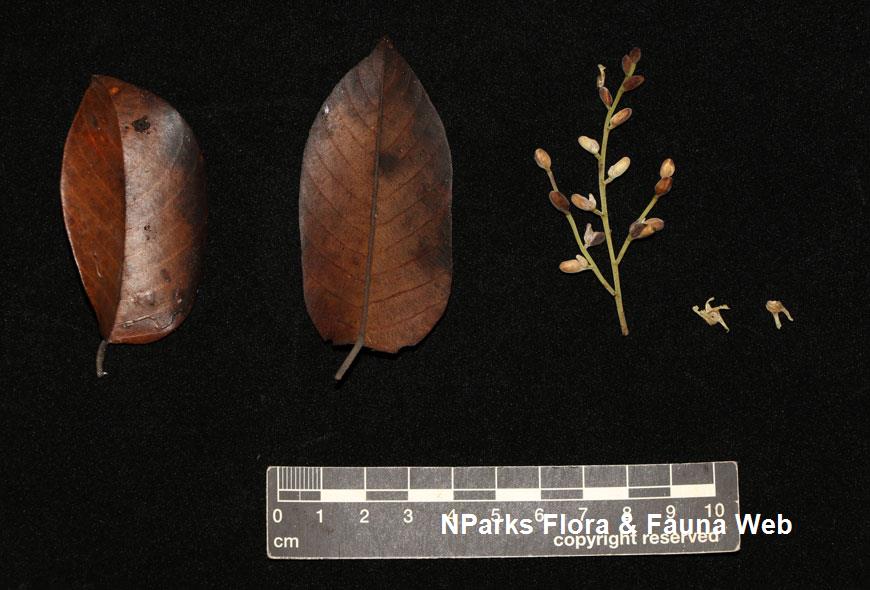
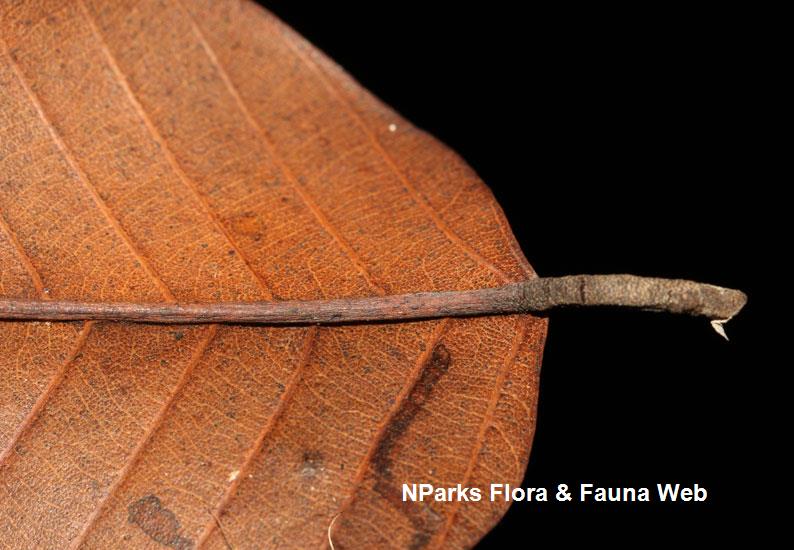
-25.jpg)
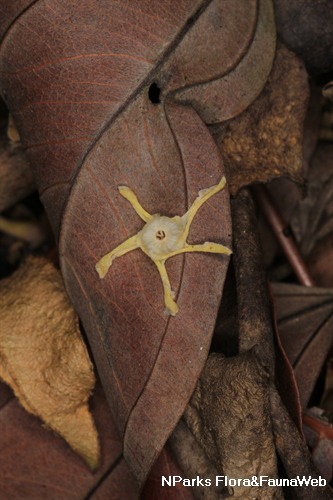
-37.jpg)
-33.jpg)
